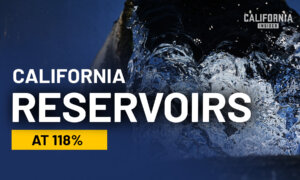A plan requiring suppliers to reduce water to California cities and counties by nearly 15 percent—and 33 percent or more in inland areas—by 2035 is raising concerns from state analysts, some of whom say that the regulations could cost billions of dollars and save only about 1 percent of water used annually.
Although such rules are directed at urban water suppliers, 95 percent of Californians who drink and use water from those agencies could also be affected by higher water rates.
At issue are regulations put forth by California’s State Water Resources Control Board in August 2023. The board is slated to vote on the proposals later this year, and if approved, the new rules will take effect Oct. 1.
However, the state’s Legislative Analyst’s Office warned in a Jan. 4 report the regulations will be difficult for water suppliers to comply with because of a limited amount of time to adapt.
“The state obviously has an interest in making more efficient use of its water supply,” Sonja Petek, author of the report and principal fiscal and policy analyst, told The Epoch Times on Jan. 5. “But how the state goes about implementing this long-term conservation framework matters, and what the water board has thus far proposed includes a lot of complexity and a fairly aggressive timeline.”
If regulators approve the rules this summer, agencies will have weeks to comply with the new infrastructure and reporting rules—and many are unaware of how to proceed, according to the report.
The reductions would also be in addition to cutbacks over the past 20 years, according to analysts.
That could create “unrealistic expectations” regarding the proposed regulations—while increasing costs and complexity, according to Ms. Petek.
“We’re not saying the proposed regulations, in total, are a problem,” she said. “We’re just saying there are some specific aspects that are particularly stringent that might need some softening if all of the water suppliers have a chance of complying.”
Water use objectives would be calculated for suppliers based on reductions of prior year totals. Starting in 2027, the state can fine suppliers that exceed those limits, with penalties of $1,000 per day up to $10,000 daily during drought years.
“We find ... [the resource board’s] proposed regulations will create challenges for water suppliers in several key ways, in many cases without compelling justifications,” the report reads.
Challenges facing water agencies include complying with required administrative reporting and convincing customers to reduce use to allow suppliers to meet the new water requirements.
Regulators have said that the changes are needed to achieve water conservation objectives—including expanding storage, developing new water supplies, and promoting more efficient water use—and limiting widespread water use during dry years.
“The proposed regulation seeks to cultivate long-term practices that help communities adapt to California’s ongoing water challenges and lessen the need for the kinds of emergency water use reduction targets that were important in recent droughts,” an August statement from the water board reads.

Water flows into the Los Angeles Aqueduct at Moffat Ranch Road along Highway 395 in Inyo County, Calif., on April 7, 2023. (Patrick T. Fallon/AFP via Getty Images)
Action from the board was prompted by the passage of two bills in 2018, one each from the Assembly and Senate, designed to reduce water use.
Assembly Bill 1668 ordered the water board to propose regulations—with plans to have the new rules soon after, though years of delays, attributed primarily to the pandemic, led to the current timeline.
Originally intended to be an analysis of implementation and compliance, the legislative analyst’s report now serves as an “early assessment” of “potential implementation challenges.”
With water being saved representing about 1 percent of the amount used in a year and costs estimated to exceed benefits by billions of dollars, analysts questioned the value of the proposal.
“Whether all of this work and effort—as the regulations are currently proposed—is worth it was a question in our mind,” Ms. Petek told The Epoch Times. “That said, we do recognize that conservation is really important.”
Citing expected costs of tens of billions of dollars between 2025 and 2040 that will be borne by water suppliers and consumers, the report says low-income Californians will pay a disproportionate share of the cost.
Analysts said those with less means are not able to pay for landscape adaptations and new technologies that can help reduce water use, thus leaving them more susceptible to higher water rates.
Because rates are the primary source of revenue for water suppliers, analysts expect them to increase as the regulations take effect, as costs of doing business will increase for water suppliers because of reporting mandates and implementation challenges.
“The performance measures suppliers must implement for commercial customers are unnecessarily complex, lack clarity in places, and will be administratively burdensome to implement,” the report said. “Any savings achieved would be small and come at a large cost to suppliers.”
If ultimately approved, with little time to implement the new regulations, some water agencies could fail to meet deadlines, according to the report.
“These statutory timelines likely will be difficult for suppliers to meet—particularly given the delay in defining specific regulatory requirements—and could lead to adverse outcomes,” the report reads. “Although the requirements are phased in over multiple years, the timeline for full implementation may be too aggressive given the number of changes that will have to occur to achieve the level of conservation envisioned.”
With up-front costs expected to present obstacles for many of the state’s water suppliers and consumers’ affordability issues potentially worsened, analysts highlighted the “particularly worrisome” difficulties associated with the proposal.
Lawmakers have about five months to take the report into consideration and possibly make changes before the water board adopts regulations this summer. Analysts have recommended simplifying compliance, easing implementation, and lowering associated costs.
“While our recommended changes could reduce the amount of potential water savings somewhat, slightly easing the standards could increase the likelihood of actually achieving those savings,” the report reads.

Water access in Long Beach, Calif., on Dec. 13, 2023. (John Fredricks/The Epoch Times)














